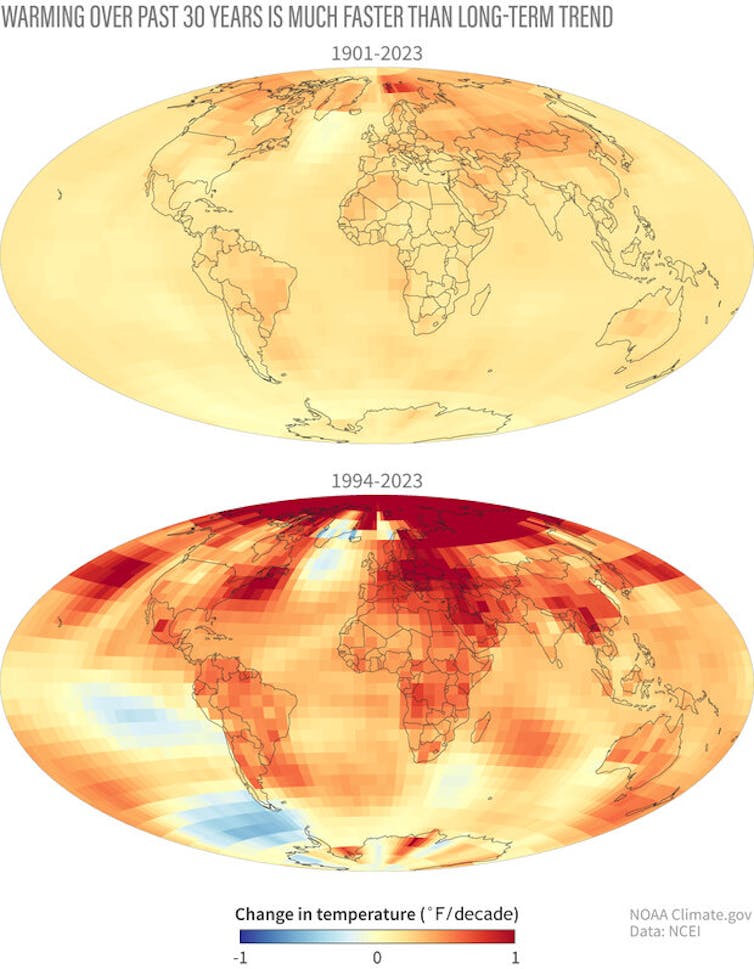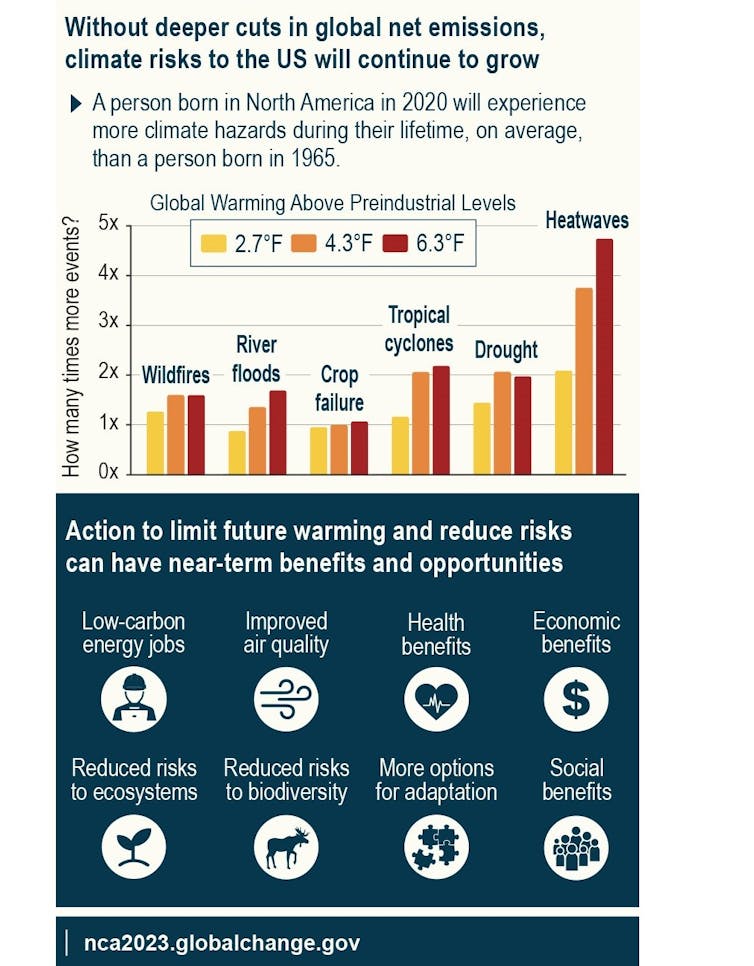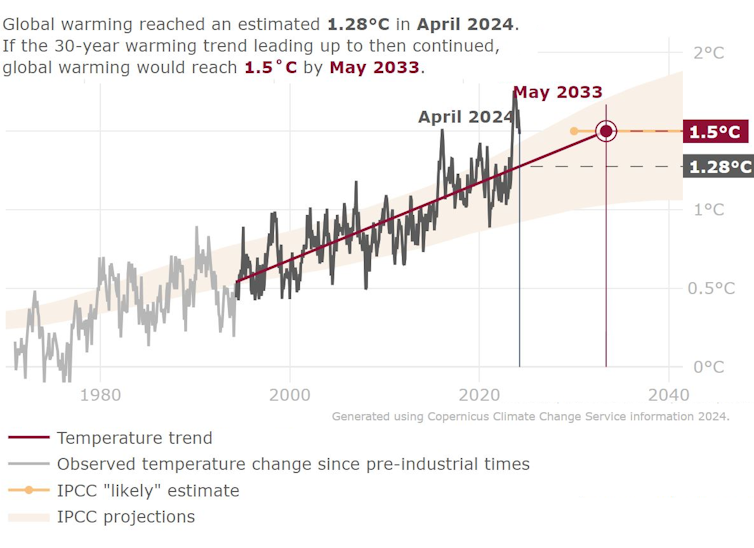Less than a month into summer 2024, the vast majority of the U.S. population has already experienced an extreme heat wave. Millions of people were under heat warnings across the western U.S. in early July or sweating through humid heat in the East.
Death Valley hit a dangerous 129 degrees Fahrenheit (53.9 C) on July 7, a day after a motorcyclist died from heat exposure there. Las Vegas broke its all-time heat record at 120 F (48.9 C). In California, days of over-100-degree heat in large parts of the state dried out the landscape, fueling wildfires. Oregon reported several suspected heat deaths.
Extreme heat like this has been hitting countries across the planet in 2024.
Globally, each of the past 13 months has been the hottest on record for that month, including the hottest June, according to the European Union’s Copernicus climate service. The service reported on July 8, 2024, that the average temperature for the previous 12 months had also been at least 1.5 C (2.7 F) warmer than the 1850-1900 pre-industrial average.
The 1.5 C warming threshold can be confusing, so let’s take a closer look at what that means. In the Paris climate agreement, countries worldwide agreed to work to keep global warming under 1.5 C, however that refers to the temperature change averaged over a 30-year period. A 30-year average is used to limit the influence of natural year-to-year fluctuations.
So far, the Earth has only crossed that threshold for a single year. However, it is still extremely concerning, and the world appears to be on track to cross the 30-year average threshold of 1.5 C within 10 years.
Global temperatures showing the trend line averaged over 30 years.
Copernicus Climate Change and Atmosphere Monitoring Services
We study weather patterns involving heat. The early season heat, part of a warming trend fueled by humans, is putting lives at risk around the world.
Heat is becoming a global problem
Record heat has hit several countries across the Americas, Africa, Europe and Asia in 2024. In Mexico and Central America, weeks of persistent heat starting in spring 2024 combined with prolonged drought led to severe water shortages and dozens of deaths.
Extreme heat turned into tragedy in Saudi Arabia, as over 1,000 people on the Hajj, a Muslim pilgrimage to Mecca, collapsed and died. Temperatures reached 125 F (51.8 C) at the Grand Mosque in Mecca on June 17.
Hospitals in Karachi, Pakistan, were overwhelmed amid weeks of high heat, frequent power outages, and water shortages in some areas. Neighboring India faced temperatures around 120 F (48.9 C) for several days in April and May that affected millions of people, many of them without air conditioning.
In Greece, where temperatures were over 100 F (37.8 C) for days in June, several tourists died or were feared dead after going hiking in dangerous heat and humidity.
Japan issued heatstroke alerts in Tokyo and more than half of its prefectures as temperatures rose to record highs in early July.
The climate connection: This isn’t ‘just summer’
Although heat waves are a natural part of the climate, the severity and extent of the heat waves so far in 2024 are not “just summer.”
A scientific assessment of the fierce heat wave in the eastern U.S. in June 2024 estimates that heat so severe and long-lasting was two to four times more likely to occur today because of human-caused climate change than it would have been without it. This conclusion is consistent with the rapid increase over the past several decades in the number of U.S. heat waves and their occurrence outside the peak of summer.
These record heat waves are happening in a climate that’s globally more than 2.2 F (1.2 C) warmer – when looking at the 30-year average – than it was before the industrial revolution, when humans began releasing large amounts of greenhouse gas emissions that warm the climate.

Global surface temperatures have risen faster per decade in the past 30 years than over the past 120.
NOAA NCEI
While a temperature difference of a degree or two when you walk into a different room might not even be noticeable, even fractions of a degree make a large difference in the global climate.
At the peak of the last ice age, some 20,000 years ago, when the Northeast U.S. was under thousands of feet of ice, the globally averaged temperature was only about 11 F (6 C) cooler than now. So, it is not surprising that 2.2 F (1.2 C) of warming so far is already rapidly changing the climate.
If you thought this was hot
While this summer is likely be one of the hottest on record, it is important to realize that it may also be one of the coldest summers of the future.
For populations that are especially vulnerable to heat, including young children, older adults and outdoor workers, the risks are even higher. People in lower-income neighborhoods where air conditioning may be unaffordable and renters who often don’t have the same protections for cooling as heating will face increasingly dangerous conditions.
Extreme heat can also affect economies. It can buckle railroad tracks and cause wires to sag, leading to transit delays and disruptions. It can also overload electric systems with high demand and lead to blackouts just when people have the greatest need for cooling.
The good news: There are solutions
Yes, the future in a warming world is daunting. However, while countries aren’t on pace to meet their Paris Agreement goals, they have made progress.
In the U.S., the 2022 Inflation Reduction Act has the potential to reduce U.S. greenhouse gas emissions by nearly half by 2035.
Switching from air conditioners to heat pumps and network geothermal systems can not only reduce fossil fuel emissions but also provide cooling at a lower cost. The cost of renewable energy continues to plummet, and many countries are increasing policy support and incentives.

Actions to reduce warming can limit a wide range of hazards and create numerous near-term benefits and opportunities. National Climate Assessment 2023
There is much that humanity can do to limit future warming if countries, companies and people everywhere act with urgency. Rapidly reducing fossil fuel emissions can help avoid a warmer future with even worse heat waves and droughts, while also providing other benefits, including improving public health, creating jobs and reducing risks to ecosystems.
This is an update to an article originally published on June 26, 2024.![]()
This article is republished from The Conversation under a Creative Commons license. Read the original article.






